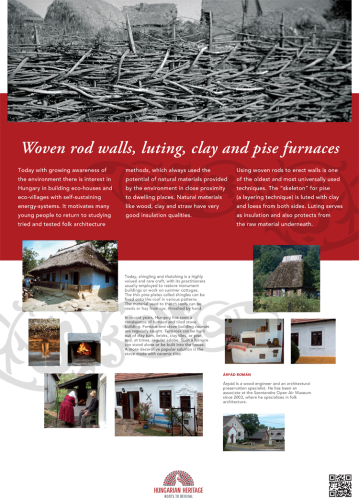 Today with growing awareness of the environment there is interest in Hungary in building eco-houses and eco-villages with self-sustaining energy-systems. It motivates many young people to return to studying tried and tested folk architecture methods, which always used the potential of natural materials provided by the environment in close proximity to dwelling places. Natural materials like wood, clay and straw have very good insulation qualities.
Today with growing awareness of the environment there is interest in Hungary in building eco-houses and eco-villages with self-sustaining energy-systems. It motivates many young people to return to studying tried and tested folk architecture methods, which always used the potential of natural materials provided by the environment in close proximity to dwelling places. Natural materials like wood, clay and straw have very good insulation qualities.
Using woven rods to erect walls is one of the oldest and most universally used techniques. The “skeleton” for pise (a layering technique) is luted with clay and loess from both sides. Luting serves as insulation and also protects from the raw material underneath.
Today, shingling and thatching is a highly valued and rare craft, with its practitioners usually employed to restore monument buildings or work on summer cottages. The thin pine plates called shingles can be fixed onto the roof in various patterns. The material used to thatch roofs can be reeds or hay from rye, threshed by hand.
In recent years, Hungary has seen a renaissance of furnace and tiled stove building. Furnace and stove building courses are regularly taught. Furnaces can be built out of clay bars, bricks, clay tiles, or pise, and, at times, regular adobe. Such a furnace can stand alone or be built into the house. A more decorative popular solution is the stove made with ceramic tiles.
Árpád Román
Árpád is a wood engineer and an architectural preservation specialist. He has been an associate at the Szentendre Open Air Museum since 2003, where he specializes in folk architecture.






